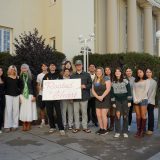Orange is the New White
October 3, 2014

Wayne White
Drop the Country Boy Act, 2008
Print, 39.5 x 30″
Purchased with acquisition funds, 2009
Wayne White is a pioneer for humor in the art world. He’s famous as a puppeteer, set designer, cartoonist, painter, and more. His “word paintings,” of which we have three on campus, are humorous and witty. White often uses generic landscapes he finds at thrift shops as canvases, painting phrases such as “You’re just agreeing with me so I’ll shut up,” “The most expensive painting in the world,” and my personal favorite, “Honey wheres my learnin books.” What makes White’s paintings even more unique is his ability to seamlessly insert the letters into the landscape background, mirroring the colors, brush strokes, and perspective.
Needless to say, the main focal point of these paintings is the letters. In his 2013 TEDx Talk, White discussed his inspiration:
“My earliest memories are giant letters in the supermarket—I was always intrigued by letters, even before I could read. They had such a strange power. I saw each letter as a different personality, as a magic totem.”
If we compare his word paintings to the graphics on products from the 1950s and 60s, when he was growing up, there are striking similarities. The text is bold, dynamic, and dominates the image.

Citrus Crate Label, 1930s-1960s
Interestingly enough, while walking through the Escalette Collection in Beckman Hall the other day, I noticed this type of text again, in the produce crate labels from old California. The letters are just as charismatic and powerful as those in White’s work. In both his paintings and in the labels there is some degree of three-dimensionality, and in both, the letters make the piece. From a purely aesthetic perspective, it’s not so much what they say, but how they say it. In other words, these specific words don’t matter as much as their shapes.
It’s interesting to see the influence of bold lettering on White’s work, and perhaps even more interesting to see a relation between the lettering that White himself cited as inspiration and the lettering on these early California crate labels.


